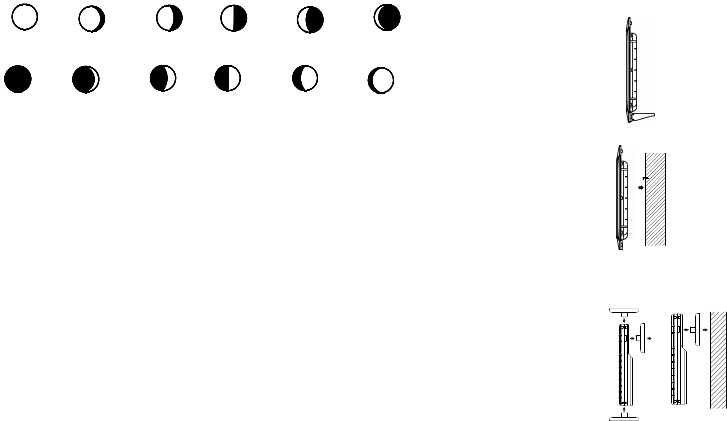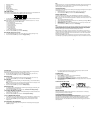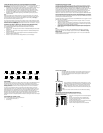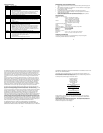
9
915MHz RECEPTION CHECK FOR OUTDOOR TEMPERATURE SENSOR
The atomic clock will receive the temperature data within 3 minutes. If the temperature data is not
being received 3 minutes after setting up (the display shows “- - -”), then please check the
following points:
1. The distance of the atomic clock or outdoor temperature sensor should be at least 6 feet (2
meters) away from any interfering sources such as computer monitors or TV sets.
2. Avoid placing the receiver onto or in the immediate proximity of metal window frames.
3. Using other electrical products such as headphones or speakers operating on the same
signal frequency (915MHz) may prevent correct signal transmission and reception.
4. Neighbors using electrical devices operating on the 915MHz signal frequency can also
cause interference.
Note:
When the 915 MHz signal is received correctly, do not re-open the battery cover of either the
outdoor temperature sensor or atomic clock, as the batteries may spring free from the contacts
and force a false reset. Should this happen accidentally then reset all units (see Setting up
above) otherwise transmission problems may occur.
The maximum transmission range is 330 feet (100 meters) from the outdoor temperature sensor
to the atomic clock (in open space). However, this depends on the surrounding environment and
interference levels. If no reception is possible despite the observation of these factors, all system
units have to be reset (see Setting up).
CHANGING THE DISPLAY MODE (DAY, SECONDS, AND TEMPERATURES)
There are 4 possible display modes to view the day, seconds, and temperatures.
The month&date/weekday/indoor temperature/outdoor temperature is the default.
To change the display:
1. Press the + key. The display should now show the month&date/weekday/seconds/outdoor
temperature.
2. Press the + key a second time and the display will show the month&date/weekday/indoor
temperature/seconds.
3. Press the + key a third time and the display will show the month&date/seconds/indoor
temperature/outdoor temperature.
4. Press the + key a fourth time and the display will return to the normal display.
10
WWVB RADIO CONTROLLED TIME
The NIST radio station, WWVB, is located in Ft. Collins, Colorado and transmits the exact time
signal continuously throughout the United States at 60 kHz. The signal can be received up to
2,000 miles away through the internal antenna in the atomic clock. However, due to the nature of
the Earth’s Ionosphere, reception is very limited during daylight hours. The atomic clock will
search for a signal every night when reception is best. The WWVB radio station derives its signal
from the NIST atomic clock in Boulder, Colorado. A team of atomic physicists continually
measures every second of every day to an accuracy of ten billionths of a second a day. These
physicists have created an international standard, measuring a second as 9,192,631,770
vibrations of a Cesium 133 atom in a vacuum. This atomic clock regulates the WWVB transmitter.
Once the outdoor temperature is displayed on the atomic clock, the WWVB tower icon in the clock
display will start flashing in the top center of the LCD. This indicates that the clock has detected a
radio signal and is trying to receive it. When the time code is received, the WWVB tower becomes
permanently lit and the time will be displayed.
If the tower icon flashes, but does not set the time or the WWVB tower does not appear at all, then
please take note of the following:
• Recommended distance to any interfering sources like computer monitors or TV sets is a
minimum of 6 feet (2 meters).
• Within ferro-concrete rooms (basements, superstructures), the received signal is naturally
weakened. In extreme cases, please place the unit close to a window and/ or point its front
or back towards the Fort Collins, Colorado, transmitter.
• During nighttime, the atmospheric disturbances are usually less severe and reception is
possible in most cases. A single daily reception is adequate to keep the accuracy deviation
below 1 second.
Note:
In case the atomic clock is not able to detect the WWVB-signal (disturbances, transmitting
distance, etc.), the time can be manually set (please refer to notes on Manual time setting).
MOON PHASE
The Moon Phases and their corresponding dates appear in LCD 2. There are 12 visible Moon
Phases that will show in the LCD 2:
11
New Moon Small Waxing Large Waxing First Quarter Small Waxing Large Waxing
Crescent Crescent Gibbous Gibbous
FullMoon Large Waning Small Waning Last Quarter Large Waning Small Waning
Gibbous Gibbous Crescent Crescent
POSITIONING
Before permanently mounting ensure that the atomic clock is able to receive WWVB signals from
the desired location. Also, extreme and sudden changes in temperature will decrease the
accuracy of the atomic clock, and changes in elevation will result with inaccurate temperatures
readings for the next 12 to 24 hours. These changes will require a 12 to 24 hour wait before
obtaining reliable data.
To achieve a true temperature reading, avoid mounting where direct sunlight can reach the
outdoor temperature sensor. It is recommended to mount the outdoor temperature sensor on a
North-facing wall or in any well shaded area. The maximum transmitting range is 330 feet (100
meters) obstacles such as walls, concrete, and large metal objects can reduce the range.
Place both units in their desired location, and wait approximately 10 minutes before permanently
mounting to ensure that there is proper reception. The outdoor temperature sensor is not
waterproof and should not be placed anywhere it will become submerged in water or be directly in
the rain.
POSITIONING THE ATOMIC CLOCK:
There are two possible ways to mount the atomic clock:
• use of the foldout table stands, or
• wall mounting
12
FOLDOUT TABLE STANDS
The foldout table stands are located on the backside. Pull the stands out from
the bottom center edge of the atomic clock, below the battery compartment.
Once the foldout table stands are extended, place the atomic clock in an
appropriate location.
WALL MOUNTING
1) Using a straightedge, horizontally space three screw positions on a wall.
2) Install three mounting screws (not included) into a wall within transmission
range—leaving approximately 3/16 of an inch (5mm) extended from the
wall.
3) Place the atomic clock onto the screws, using the hanging holes on the
backside. Gently pull the atomic clock down to lock the screws into place.
Note:
Always ensure that the atomic clock locks onto the screws before releasing.
POSITIONING THE OUTDOOR TEMPERATURE SENSOR
The remote temperature sensor can be mounted with the use of screws
MOUNTING WITH SCREWS
1) Remove the mounting bracket from the remote temperature
sensor.
2) Place the mounting bracket over the desired location.
3) Through the three screw holes of the bracket, mark the
mounting surface with a pencil.
4) Screw mounting bracket onto the mounting surface. Ensure
that the screws are flush with the bracket.
5) Insert the remote temperature sensor into the bracket.






